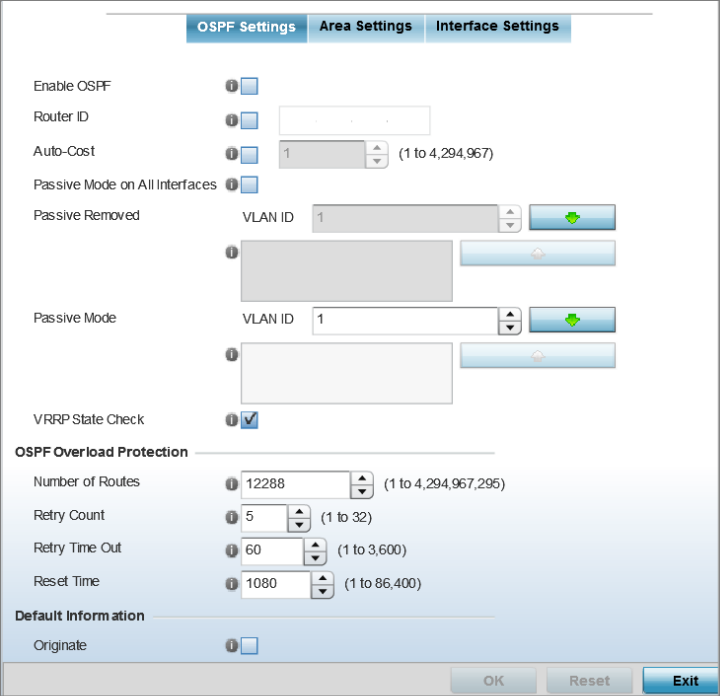Profile Overrides - OSPF Settings
About this task
OSPF (Open Shortest Path First) is a link-state IGP (interior gateway protocol). OSPF routes IP packets within a single routing domain (autonomous system), like an enterprise LAN. OSPF gathers link state information from neighbor routers and constructs a network topology. The topology determines the routing table presented to the Internet Layer which makes routing decisions based solely on the destination IP address found in IP packets.
To override a profile's OSPF configurations:
Procedure
-
Go to Configuration →
Devices.
The Device Configuration screen displays. This screen lists wireless controllers, service platforms and access points within the managed network.
-
Select a device from the list
displayed.
The selected device's configuration screen displays.
-
Expand Profile Overrides
→ Network and select OSPF.
The OSPF → OSPF Settings configuration screen displays.
 Profile Overrides - OSPF Settings Configuration Screen
Profile Overrides - OSPF Settings Configuration Screen
-
Select the Enable
OSPF check box, and provide the following dynamic routing
settings:
Router ID
Select this option to define a router ID (numeric IP address). This ID must be established in every OSPF instance. If not explicitly configured, the highest logical IP address is duplicated as the router identifier. However, since the router identifier is not an IP address, it does not have to be a part of any routable subnet in the network.
Auto-Cost
Select this option to specify the reference bandwidth (in Mbps) used to calculate the OSPF interface cost if OSPF is either STUB or NSSA. The default setting is 1.
Passive Mode on All Interfaces
When selected, all layer 3 interfaces are set as an OSPF passive interface. This setting is disabled by default.
Passive Removed
If enabling Passive Mode on All Interfaces, use the spinner control to select VLANs (by numeric ID) as OSPF non passive interfaces. Multiple VLANs can be added to the list.
Passive Mode
If disabling Passive Mode on All Interfaces, use the spinner control to select VLANs (by numeric ID) as OSPF passive interfaces. Multiple VLANs can be added to the list.
VRRP State Check
Select this option to enable checking of VRRP state. If the interface‘s VRRP state is not Backup, then the interface is published via OSPF.
-
Set the following OSPF Overload
Protection parameters:
Number of Routes
Use the spinner controller to set the maximum number of OSPN routes permitted. The available range is from 1 - 4,294,967,295.
Retry Count
Set the maximum number of retries (OSPF resets) permitted before the OSPF process is shut down. The available range is from 1 - 32. The default setting is 5.
Retry Time Out
Set the duration (in seconds) the OSPF process remains off before initiating its next retry. The available range is from 1 - 3,600 seconds. The default is 60 seconds.
Reset Time
Set the reset time (in seconds) that, when exceeded, changes the retry count is zero. The available range is from 1 - 86,400. The default is 360 seconds.
-
Set the following Default
Information:
Originate
Select this option to make the default route a distributed route. This setting is disabled by default.
Always
Enabling this setting continuously maintains a default route, even when no routes appear in the routing table. This setting is disabled by default.
Metric Type
Select this option to define the exterior metric type (1 or 2) used with the default route.
Route Metric
Select this option to define route metric used with the default route. OSPF uses path cost as its routing metric. It‘s defined by the speed (bandwidth) of the interface supporting a given route.
-
In the Route
Redistribution table, click + Add Row and
set the types of routes that can be used by OSPF.
Route Type
Set the Route Type used to define the redistributed route. Options include: connected, kernel and static.
Metric Type
Select this check box, and define the exterior metric type (1 or 2) used with the route redistribution.
Metric
Select this option, and define route metric used with the redistributed route.
-
In the OSPF Network
table, click +Add Row and configure the following:
Network
Add the IP address and mask of the Network(s) participating in OSPF.
Area ID
Define the OSPF area (IP address) to which the network belongs.
- In the Clear OSPF Process, click Clear to clear all OSPF Routing table entries.
- Set an OSPF Default Route Priority (1 - 8,000) as the priority of the default route learnt from OSPF. The default priority is 7000.
-
Click OK to save the
OSPF setting changes.
Click Reset to revert to the last saved configuration.


